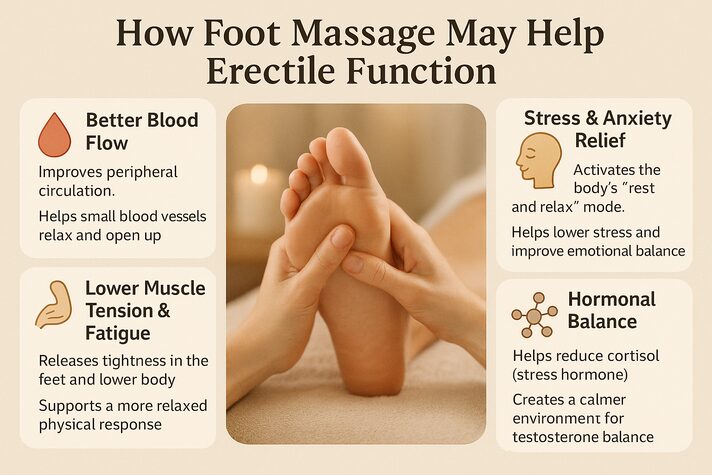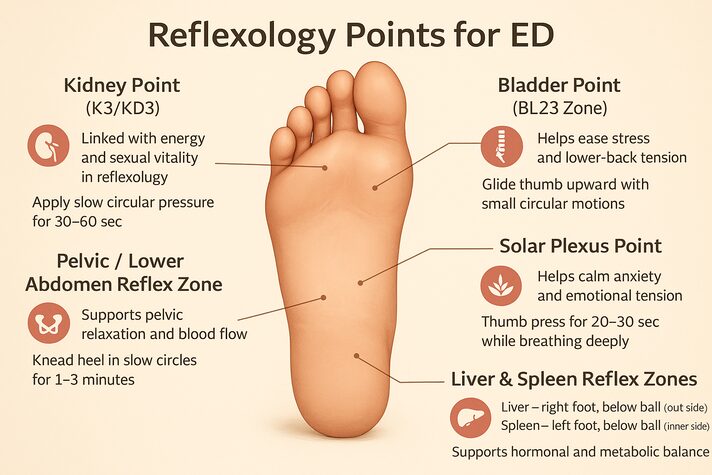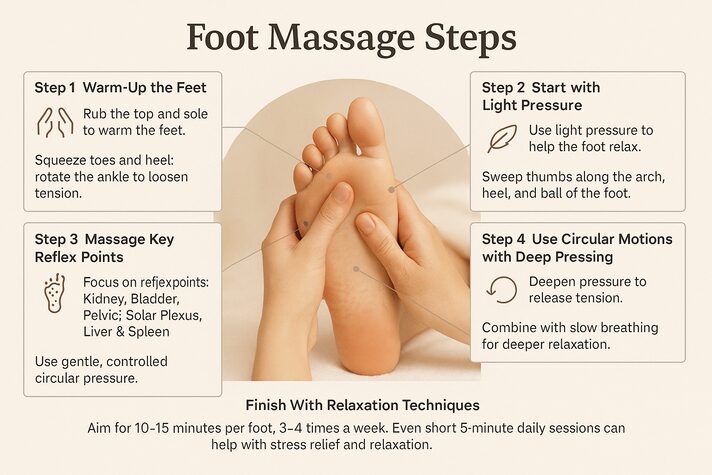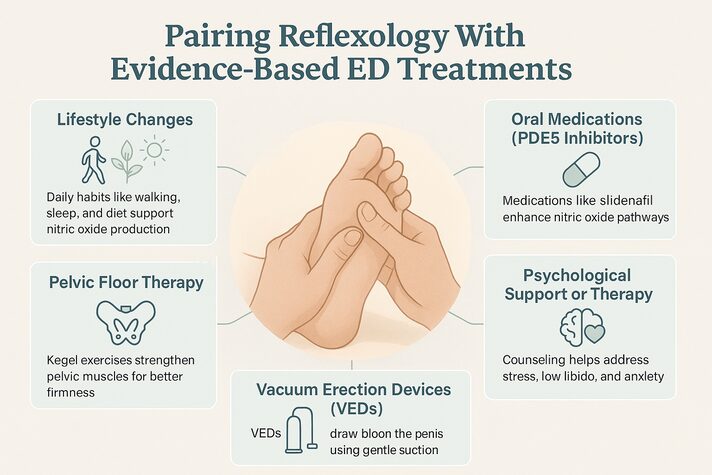Reflexology For Erectile Dysfunction: Pressure Points To Boost Sexual Energy

Foot reflexology can be a calming and supportive practice for erectile dysfunction, especially when stress, tension, or poor circulation are part of the picture. But it works best when combined with proven treatments like exercise, lifestyle changes, pelvic floor training, and doctor-recommended medication. If your symptoms last longer than three months, worsen over time, or are linked to medical conditions like diabetes or high blood pressure, it’s a good idea to speak with a sexual health specialist.
Erectile dysfunction can feel worrying, but many men are surprised to learn how strongly stress, muscle tension, and overall relaxation influence their sexual health. That’s why foot massage and reflexology often come up as areas of interest. Men are curious to try them, yet still wonder: Can foot massage really help with erectile dysfunction?
A foot massage cannot cure ED, but it can support several factors that affect sexual performance. These gentle techniques help calm the nervous system, release tight muscles, and promote healthier blood circulation. When the body feels more relaxed and balanced, it becomes easier to respond during intimacy.
In this article, we’ll explore what reflexology is, how foot massage may support erectile function, the key pressure points involved, simple techniques you can try at home, important safety tips, and when it’s the right time to speak with a doctor.
Does Reflexology Help With Erectile Dysfunction?
Reflexology cannot cure erectile dysfunction, but it is often used as a complementary therapy. It involves applying pressure to specific points on the body, which practitioners believe are connected to different organs and systems. In traditional reflexology therapy, these points are thought to be linked through energy pathways (meridian lines) that run throughout the human body.
These energy pathways are described as invisible routes and guide the flow of the body’s natural energy. When a point feels tender or sensitive, it’s often interpreted as a sign of an energy blockage in the related organ. By stimulating these points, reflexologists aim to restore balance and promote smoother energy flow throughout the body.
Reflexology can be performed on the feet, hands, or ears. However, when it comes to erectile dysfunction, most traditional teachings and modern discussions focus on foot reflexology, as the feet contain many reflex points linked to the pelvic region, stress relief, and overall circulation. One study in men found that foot reflexology improved sexual desire, orgasm quality, and satisfaction, although it did not improve actual erections.[1]
How Does Foot Reflexology Work?
Each part of the foot is believed to connect to a specific organ in the body (like the heart, lungs, bladder, or reproductive organs). Pressing or massaging these areas is believed to help those organs work better. Even though it isn’t scientifically proven, the relaxation benefits are real, such as:
- Reduced stress and anxiety
- relaxed tight muscles
- Improved sleep
- A calmer and balanced state of mind
How Foot Massage May Support Erectile Function
While foot massage isn’t a treatment for ED, it can help with several body processes that influence sexual performance. Here’s how:
1. Better Blood Flow
Foot massage improves circulation to the outer parts of the body, especially the legs, feet, and hands. Several studies have shown that massage or foot reflexology can increase peripheral blood flow, meaning the tiny blood vessels in these areas open up and allow more blood to move through them.[2] While this doesn’t directly push more blood into the penis, it does support the overall vascular system, and healthy blood vessels are essential for strong erections.
2. Stress & Anxiety Relief
- Foot massage may activate the body’s “rest and relax” mode (parasympathetic nervous system).[3] which can help calm the mind and support healthier blood pressure levels. More balanced blood pressure supports healthier blood flow, an important part of erectile function.
- A study found that foot reflexology can help improve stress, depression, anxiety, and sleep quality, and supports better emotional well-being.[4]
- Traditional massage therapies like lower back massage, acupressure therapy offer similar benefits, like relaxation, lower muscle tension, and reduced stress, which can indirectly support sexual health.
3. Lower Muscle Tension & Fatigue
Tight muscles, especially in the legs, back, and pelvis, can make the body feel tense overall. Foot massage promotes relaxation throughout the body by releasing muscle tension and reducing physical fatigue. A relaxed body responds better to sexual stimulation, and reduced tension can increase comfort, arousal, and confidence during sex.
4. Hormonal Balance
High levels of the stress hormone called cortisol can make it difficult for the body to make testosterone, a male hormone that supports sexual desire, energy, and erections.[5]. By lowering cortisol, massage may indirectly support healthier testosterone levels, which play a role in libido, energy, and erectile function. It’s not a hormone treatment, but it creates a more favorable environment for hormonal balance.

Reflexology Points For Erectile Dysfunction
1. Kidney Point (K3/KD3)
Location: Inner side of foot → soft hollow behind ankle bone
Benefits: Linked with sexual vitality & energy in reflexology
How to Try:
- Place thumb in the dip
- Slow circular pressure
- 30–60 seconds for each foot
2. Bladder Point (BL23 Zone)
Location: Inner arch → heel to mid-foot
Benefits: Eases stress & lower-back tension
How to Massage:
- Thumb gliding upward
- Small circular motions
- 1–2 minutes per foot
3. Pelvic / Lower Abdomen Reflex Zone
Location: Heel area → center + inner heel
Benefits: Supports pelvic relaxation & blood flow
Technique:
- Knead heel in slow circles
- 1–3 minutes per foot
4. Solar Plexus Point
Location: Center of foot → just below the ball of the foot
Benefits: Calms anxiety & emotional tension (big ED triggers)
How to Press:
- Thumb press + deep breathing
- Hold 20–30 seconds
- Release slowly
5. Liver & Spleen Reflex Zones
Location:
- Liver → Right foot, below ball (outer side)
- Spleen → Left foot, below ball (inner side)
Benefits: Supports hormonal & metabolic balance (indirect)
How to Massage:
- Slow circular thumb motions
- 30–60 seconds each zone

How To Try Foot Massage For ED At Home
Before you start, remember that foot massage works best when your body is calm and relaxed. The goal isn’t to fix ED in one session, but to help your body loosen up, improve blood flow, and reduce tension. Here’s a simple way to try it at home:
Step 1: Warm-Up The Feet
Warm the feet to improve comfort and circulation before starting.
- Rub the top and bottom of the foot.
- Gently squeeze the toes and heel.
- Rotate the ankle to loosen tension.
Step 2: Start With Light Pressure
Begin with gentle pressure to help the foot relax.
- Lightly sweep your thumbs across the sole.
- Press gently along the arch, heel, and ball.
- Go slow and adjust if you feel any tender spots.
Step 3: Massage Key Reflex Points
Once the foot is warmed and relaxed, move to the main reflex points that may support sexual wellbeing and stress relief. Spend focused time on each point using gentle, controlled pressure.
- Kidney Point (K3)
- Bladder Reflex Zone
- Pelvic/Lower Abdomen Zone
- Solar Plexus Point
- Liver & Spleen Reflex Zones
Step 4: Use Circular Motions With Deep Pressing
After working the points, deepen the massage to release tension. This helps stimulate the reflex areas more effectively and supports overall relaxation.
- Use circular thumb motions along the arch and heel.
- Press deeper (comfortably) into the key reflex points.
- Combine with slow breathing to enhance relaxation.
Step 5: End With Full Foot Relaxation Techniques
Finish with soothing movements to calm the nervous system. This helps the body shift into rest mode, which is beneficial for stress-related erectile dysfunction.
- Glide your palms from heel to toes in a long, sweeping motion.
- Gently shake or wiggle the foot to release tension.
- Stretch the toes and rotate the ankle slowly.
Aim for 10–15 minutes per foot per session, done 3–4 times per week for the best results. If you prefer something quicker, even short daily sessions of around 5 minutes can help with stress relief and overall relaxation.
Safety Tips To Keep In Mind
- Use gentle pressure if you’re new to reflexology or have sensitive feet.
- Stop immediately if you feel sharp, shooting, or unusual pain.
- Avoid deep pressure on bruised or tender areas.
- Keep sessions short (5–15 minutes) if you experience swelling, numbness, or tingling.
- Consult a doctor if you have a chronic health condition affecting your feet.
While reflexology can be a helpful part of your routine, it’s still important to know when your body needs proper medical care. You should see a sexual health specialist if the symptoms of ED last longer than three months, notice pain, numbness, or a very low libido, or if you have conditions like diabetes or high blood pressure that can affect blood flow and contribute to ED. Getting the right support early can make a big difference in your recovery.
“Think of reflexology as a supportive tool. It helps with circulation and calmness, but if erectile dysfunction is persistent, we still need to look at the bigger medical picture.

Pairing Reflexology With Evidence-Based ED Treatments
Reflexology can be a relaxing and supportive add-on, but it works best when paired with treatments that address the root causes of erectile dysfunction. ED often develops from a mix of physical, hormonal, and emotional factors, so combining therapies usually leads to the most noticeable improvements.
1. Lifestyle Changes
While reflexology helps calm the body and ease tension, healthy daily habits play an equally important role in sexual function. Regular activities like walking, better sleep, and a balanced diet naturally support nitric oxide production, a chemical that improves blood circulation and helps blood vessels relax. Together, these habits strengthen the vascular system, support healthier circulation, and contribute to better sexual performance.
Vitamin D deficiency is also common and can affect mood, energy, and hormone levels. Improving vitamin D through sunlight, supplements, or diet may support overall sexual health and well-being.
2. Oral Medications
ED medications known as PDE5 inhibitors, such as sildenafil or low-dose tadalafil, enhance the nitric oxide pathways and improve blood circulation. Reflexology, meanwhile, focuses on stimulating specific pressure points that may help reduce stress and increase comfort during intimacy. Because reflexology does not interact with these medications, it can be safely used alongside them as a supportive therapy.
3. Pelvic Floor Therapy (Kegels)
Pelvic floor exercises like Kegels directly improve erectile firmness by strengthening the muscles involved in sustaining an erection. Reflexology complements this approach by reducing muscle tension and promoting relaxation, which can make these exercises easier and more consistent to perform.
4. Psychological Support Or Therapy
Psychological symptoms such as stress, anxiety, or low libido often respond best to a combined approach. Sexual counseling and reflexology work especially well together to support both the mind and body. Counseling addresses performance anxiety and unhelpful thought patterns, while reflexology helps calm the body and shift it into a restful state.
5. Vacuum Erection Devices (VEDs)
Vacuum devices use gentle suction to draw blood into the penis and a tension ring to help maintain the erection. Reflexology can complement VED use by lowering stress and improving relaxation before intimacy, helping create a more comfortable and responsive environment for sexual activity.

Conclusion
Foot massage and reflexology can be valuable tools for relaxation, stress relief, and overall well-being, factors that play a meaningful role in sexual health. Although scientific evidence is limited when it comes to reflexology as a direct treatment for erectile dysfunction, many men still find it helpful as a supportive practice. It can calm the mind, ease physical tension, and create a more relaxed state for intimacy.
Because ED often has multiple causes, the most effective approach usually involves a combination of medical care, lifestyle changes, mental health support, and evidence-based treatments. Reflexology fits naturally into this broader plan as a gentle, low-risk technique that helps improve body awareness and reduce stress, both of which can make a real difference in sexual well-being.
"The following blog article provides general information and insights on various topics. However, it is important to note that the information presented is not intended as professional advice in any specific field or area. The content of this blog is for general educational and informational purposes only.
Book consultation
The content should not be interpreted as endorsement, recommendation, or guarantee of any product, service, or information mentioned. Readers are solely responsible for the decisions and actions they take based on the information provided in this blog. It is essential to exercise individual judgment, critical thinking, and personal responsibility when applying or implementing any information or suggestions discussed in the blog."





